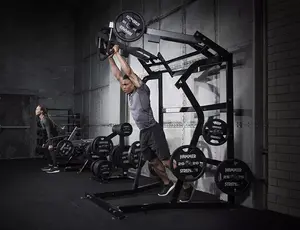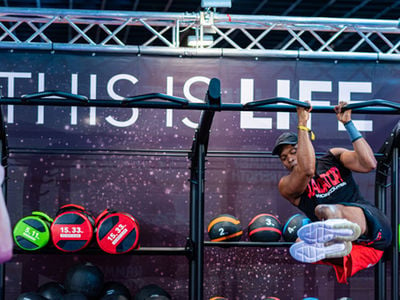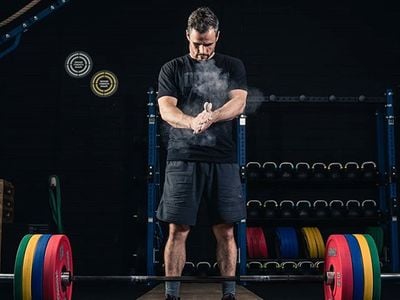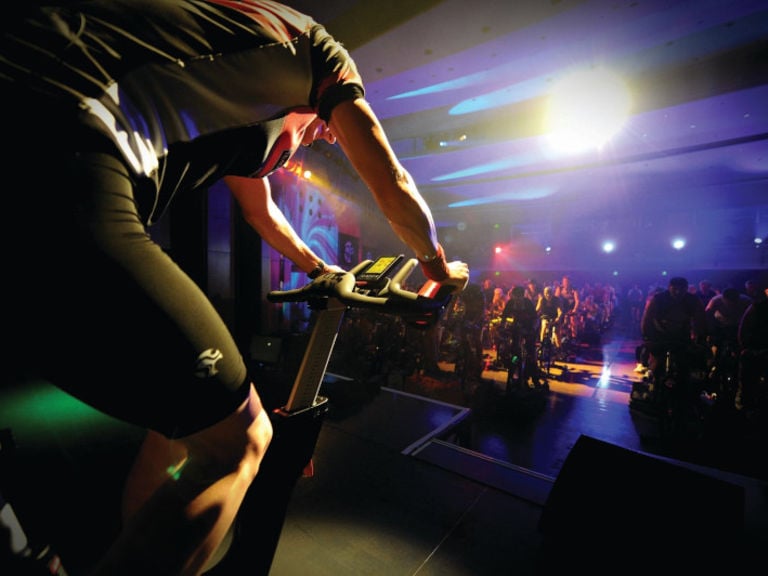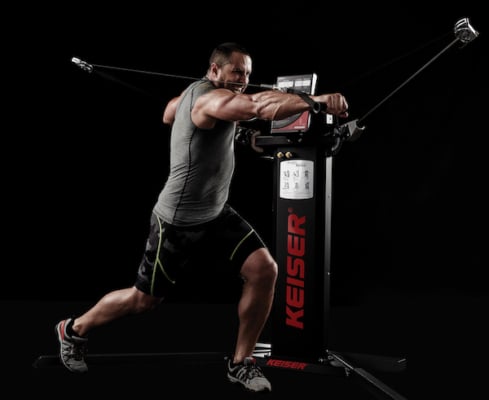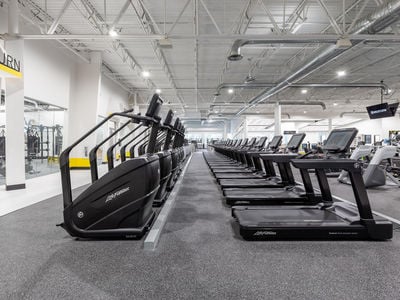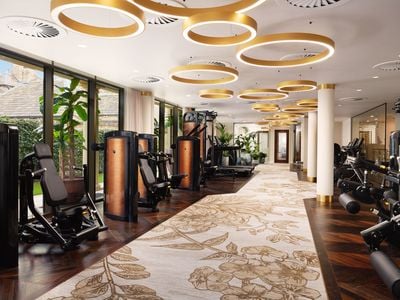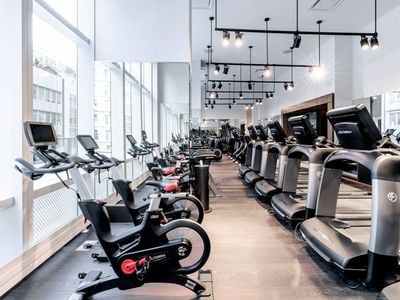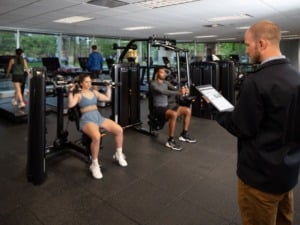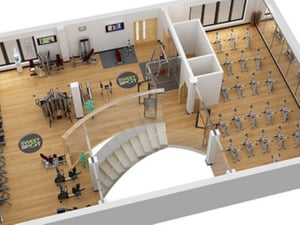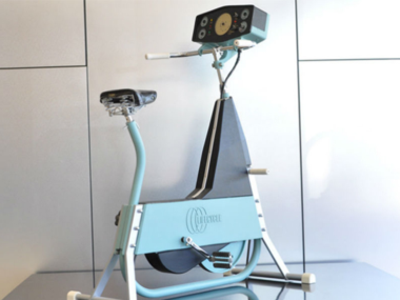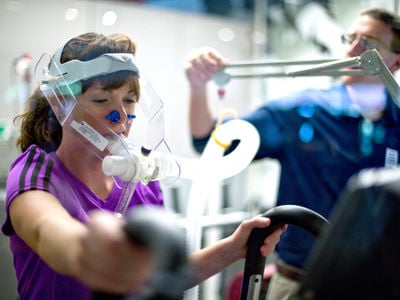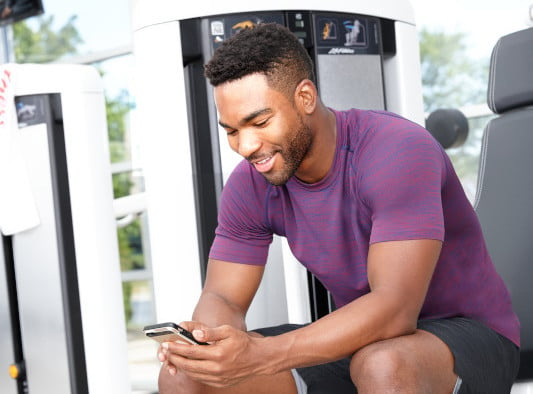If you’re shopping for gym equipment, one big question often comes up — should you stick with home gym gear or invest in commercial-grade machines?
The truth is, home and commercial gym equipment each have their own strengths, and the best choice depends on budget, space and training style. Below, we’ll do a fitness equipment comparison based on factors you should consider to help you make the smartest decision.
Durability and build quality
One of the biggest differences between home and commercial gym equipment is how they’re built. Home gym equipment is made for personal use, meaning it’s tough enough for daily workouts but not designed to handle back-to-back users. The materials are typically of high quality but are often lighter and more compact, so the pieces and machines are easier to move and set up.
Commercial gym equipment is built for heavy, continuous use, using reinforced steel frames, thick cables and advanced coatings to prevent wear and tear. These machines are designed to last, even under intense high-load training.
Size and space considerations
How much room you have matters. Home gym gear delivers compact designs, foldable features and multi-use functions that let you make the most of your setup. You still get versatile strength and cardio training without cluttering your space. Meanwhile, commercial gym equipment is built for large-scale gym floors. These machines are bigger, heavier and less adaptable, which may not be the best fit for small spaces.
If you have limited space, home gym equipment is the smarter option. But if you want the ultimate workout experience every training session, commercial machines could be the way to go.
Performance and features
When doing a fitness equipment comparison, you’ll find both home and commercial gym machines get the job done. But the level of customisation, resistance and technology can make a big difference in the workout experience.
Home gym equipment gives one all the essentials — dumbbells, adjustable benches, treadmills and multi-use machines — while keeping things simple and effective. However, weight capacities are typically lower than commercial machines. For most users, home gym gear offers more than enough resistance to build strength and endurance.
Commercial gym equipment is built for maximum performance, with heavier weight stacks, high-tech interfaces and ultra-smooth movement. Many commercial cardio machines also come with bigger touchscreens, built-in apps and real-time workout tracking. All of these extra features can make a massive difference in an individual’s workout, helping them improve their strength, endurance and performance.
If you want gym-level resistance and pro-level tracking, commercial gym equipment has the edge. But if your focus is solid training without unnecessary extras, home gym equipment delivers everything you need.
Price and long-term value
Let’s talk numbers because price is often a critical deciding factor, especially if you’re purchasing multiple pieces of gym equipment at once.
Rubber dumbbells can cost anywhere from $70 to $7,000, depending on the size and quality of the set. Meanwhile, a high-quality home treadmill typically costs from $4000 up. Commercial gym equipment, on the other hand, comes with a higher price tag. However, if you’re willing to wait, you might be able to get your hands on a set of refurbished commercial gym equipment at a discounted price, giving you the best equipment the market has to offer for less.
Another thing to keep in mind is cleaning supplies, such as wipes or disinfectant spray. While they might not seem like a significant upfront cost, you will need to replenish your stock, which can add up over time.
If you’re after something more affordable, home gym gear offers everything you need at a reasonable price. But if you’re looking for higher weight capacities and long-term durability, investing in commercial machines might be the right move.
Maintenance and lifespan
Both home and commercial gym equipment last a long time with proper care, but there are a few key differences. Regular maintenance, like cleaning, lubricating moving parts and checking bolts, helps extend the lifespan of home gym gear. You’ll also need to keep an eye out for loose parts to help your equipment last.
Commercial gym equipment can handle constant use, with reinforced frames and replaceable parts that keep them running for years, though they still need a good wipe-down after sessions to preserve performance. While you’ll get long-term reliability, occasional maintenance and part replacements are required to keep them performing at their best.
Home or commercial fitness equipment — what’s right for you?
Ultimately, there is no “right” answer for what kind of equipment you want to invest in, as the right choice depends on your training goals, budget and space. To help you make a decision, check out our quick overview below:
Home gym equipment is a great fit if:
- You need space-efficient machines that work in small areas.
- You want affordable, high-quality gear without unnecessary extra costs.
- You train regularly but not at commercial gym volume.
Commercial gym equipment might be worth the investment if:
- You want your home setup to have a true gym-like feel with heavier weight stacks and ultra-smooth movement.
- You prefer machines with high-tech screens, workout tracking and premium durability.
- You live in a household with more than one fitness junkie and need equipment that can handle back-to-back use.
Find the best gym equipment at Life Fitness
Life Fitness offers both home and commercial gym equipment, so you can create a setup that works for you. From dumbbells and space-saving cardio machines to heavy-duty strength training tools, you can buy quality gym equipment at Life Fitness.
Need help deciding? Tell us about your space, training style and goals, and we’ll help you find the perfect setup — whether it’s home gym gear or commercial-grade machines. Get in touch with Life Fitness today!
Starting your fitness journey is exciting, but choosing the right equipment can feel overwhelming with so many home and commercial gym equipment options out there. However, the best beginner gym equipment should be simple, effective and easy to use, so you can build a solid foundation while leaving room to progress.
In this guide, we’ll break down the best beginner-friendly equipment, how it supports your training and the key exercises to get you started.
Strength training beginner gym equipment
Strength training builds muscle, boosts metabolism and helps prevent injuries — but if it’s your first time using free weights and machines, you might not know where to begin. The key is to start with easy-to-use fitness machines and free weights that offer control, stability and adjustable resistance, so you can build confidence while progressing at your own pace.
If you’re planning to buy just one piece of beginner gym equipment, make it a solid pair of dumbbells. They’re versatile and easy to use and can scale with you as you get stronger. Choose dumbbells with rubber-coated ends (so they won’t damage your floors), anti-roll designs (so they stay put) and hard chrome-plated handles for a comfortable grip. With a good pair of dumbbells, you’ll be able to perform a range of exercises, from goblet squats to shoulder presses and bicep curls for a full-body workout.
A good adjustable bench opens up dozens of new exercises while keeping your posture locked in. Set it flat, incline or decline to target different muscle groups and pair it with dumbbells for an effective strength session. With the support of a sturdy bench, you can perform bench presses, tricep dips and step-ups to add variety to your workouts.
As beginner workout equipment, selectorised weight machines in commercial gyms are perfect for those just starting out, guiding movements while keeping resistance smooth and adjustable. If you’re training at home, compact multi-stations offer a wide exercise variety coupled with fixed paths of motion for added stability.
Cardio-building beginner gym equipment
Want to build endurance, burn calories or simply warm up? Cardio is a great and easy way for beginners to get the hang of moving their bodies. Consider machines that offer controlled intensity, easy adjustments and built-in programs to guide your workout.
No learning curve here — just step on and go. A treadmill is one of the best options for starting a workout routine, giving you full control over speed and incline so you can ease into exercise at your own pace. Look for models with shock-absorbing decks to reduce joint impact and make your steps (or strides) smooth, no matter the speed or intensity. And when you’re ready, try out a 10-minute incline walk and progress to jog intervals to get your heart pumping.
A stationary bike is one of the easiest ways to build cardiovascular endurance without stressing your joints. It’s a great piece of beginner gym equipment with adjustable resistance and digital tracking. Monitor progress and push yourself gradually as you increase resistance or perform sprints.
Rowing machines are easy-to-use fitness machines that hit your legs, core, back and arms in one fluid motion. They’re great for beginners who want to work multiple muscle groups without lifting heavy weights. A solid routine might start with a 5-minute warm-up, followed by 10 minutes of steady rowing to build stamina. For a more structured and challenging session, try 250-metre rows with 30-second breaks.
Functional and recovery-friendly beginner gym equipment
Training is one thing, but recovery and injury prevention are just as important. Functional training equipment helps improve flexibility, stability and strength without adding heavy weights.
Resistance bands are some of the best beginner workout equipment out there. They’re lightweight, easy to use and surprisingly effective while providing variable tension for strength training, stretching and rehab. Even better, they take up almost no space. Use them for band-assisted squats to build lower body strength, seated band rows for posture or resistance band shoulder raises to activate your upper body. If you’re working towards pull-ups, a band for assisted pull-ups helps you build strength without overloading your muscles too soon.
A stability ball takes everyday exercises up a notch by forcing your core to engage, helping improve balance, posture and mobility. It’s a great tool for beginners looking to build strength without heavy weights. Try seated leg lifts to activate your core, stability ball crunches for ab work or wall squats to strengthen your lower body. For an upper-body challenge, assisted push-ups with hands on the ball add extra stability work while keeping the movement beginner-friendly.
Sore muscles are part of starting a workout routine, but a foam roller makes recovery easier. It helps loosen tight spots, improve flexibility and reduce stiffness after training.
After your workout, roll out quads and hamstrings for 1-2 minutes, spend 30 seconds on each calf and glute and finish with gentle back rolling to improve mobility. A few minutes with a foam roller keeps you moving and ready for your next workout.
Start your fitness journey with the best gym equipment at Life Fitness
At Life Fitness, we offer easy-to-use fitness machines and free weights that make training simple and effective. From dumbbells and adjustable benches to cable machines, our products allow you to increase the weight as you progress. For cardio, our treadmills, bikes and rowers offer on-demand workouts that keep you engaged. Shop our collection of beginner gym equipment today.
The right equipment sets the foundation for success. Not sure which gear is best as you begin your training? Get in touch — we’ll help you choose the best beginner-friendly equipment for your gym.
From commercial gyms to boutique studios and home setups, having the right mix of essential gym gear ensures members can perform varied, effective workouts every time they visit. Whether you’re establishing a new facility or upgrading an existing space, here’s a comprehensive guide to a few of the must-have strength training equipment that every gym should have.
1. Free weights
Free weights are versatile, functional and essential for any strength training regimen. They allow exercisers to perform a wide range of workouts that target preferred muscle groups and engage their muscles for stability and coordination. Free weights can also be easily stored in home gyms with limited space.
- Dumbbells – Dumbbells are ideal for beginners and experienced lifters, offering the flexibility to perform isolated or compound movements. Anti-roll dumbbells have flat edges, keeping them from rolling away when set down. This design improves safety, keeps the workout area organised and makes swapping weights easier during workouts.
Check out our range of dumbbells and racks to suit different fitness levels and gym setups.
- Barbells and racks — Barbells are a staple for performing classic weightlifting exercises like squats, deadlifts and presses. With a strong, reliable rack system, members can safely load and unload weight plates to perform barbell exercises with optimal safety and support.
Browse our selection of barbells and racks to ensure your gym has top-tier equipment that’s built to last.
2. Weightlifting machines
Selectorised strength machines are a core part of any essential gym gear collection. They not only make workouts safer for members but also offer the support and stability needed to develop muscles safely.
These machines provide controlled movements and optimum support, making them especially suitable for beginners or members focusing on rehabilitation. These machines are designed to target specific muscle groups, making it easy to isolate muscles without engaging stabilisers.
Here are a few essential machines that every gym should have:
- Chest press machine — The chest press machine isolates the pectoral muscles and allows users to increase upper body strength with a controlled range of motion. This machine is particularly helpful for those who are new to strength training, offering stability and guidance to develop proper form.
- Lat pulldown and row machine — For targeting the upper back, lat pulldown and row machines are fundamental. They offer variety, enabling users to work the back muscles from different angles, essential for balanced upper body strength and posture.
- Leg press and extension machines — Lower body strength is crucial for overall fitness and leg-focused machines, such as leg presses and extensions, offer targeted options for developing leg muscles. These machines allow exercisers to push heavy loads with controlled movement, reducing stress on joints.
3. Adjustable benches
Adjustable benches are simple yet highly effective pieces of strength training equipment. With the ability to adjust the incline, decline and flat positions, benches offer flexibility for exercises targeting muscles from different angles. From bench presses and rows to tricep extensions and seated curls, a quality adjustable bench is the foundation for various exercises.
Adding multiple adjustable benches to your facility enables several members to perform strength exercises simultaneously, reducing wait times for equipment. Benches are highly effective when paired with dumbbells or barbells for a comprehensive strength setup.
4. Cable machines for functional training
Cable machines are vital for functional strength training, offering resistance with different angles and movements. They are popular in gyms because of their versatility, allowing users to work on various muscle groups with one piece of equipment. Cable machines enable exercisers to perform exercises such as chest flies, tricep pushdowns, glute exercises and core twists, which help build balanced strength and stability.
This strength training equipment is also highly adjustable, allowing members to customise the height, weight and angle to suit their workout preferences and body mechanics. Cable machines are perfect for members who want to incorporate functional movements that mimic real-life activities and sports-specific movements.
5. Smith machine
The Smith machine provides a controlled environment for performing exercises like squats, lunges, bench presses and overhead presses. Unlike traditional free weights, the Smith machine stabilises the barbell, reducing the risk of injury. This makes it a valuable addition to gyms catering to members of all experience levels, from beginners who may be intimidated by free weights to advanced lifters seeking a new personal record.
Including a Smith machine in your facility provides members with a reliable and safe alternative for weightlifting exercises, especially for those training solo or without a spotter.
6. Functional training tools
In addition to weightlifting machines, functional training equipment is essential for members who prefer dynamic, high-intensity workouts. Adding items like kettlebells, medicine balls and resistance bands enhances the variety of strength and cardio exercises members can perform. These tools are lightweight and portable, making them ideal for building explosive power, core stability and agility.
Functional training tools are valuable for small group training sessions, HIIT classes or personalised workout plans. They offer diverse exercises that keep members engaged and motivated.
Build a complete strength training experience with Life Fitness
Creating a well-rounded gym space requires the right balance of strength training equipment and functional training tools. By investing in essential gym gear that caters to all fitness levels, you’re positioning your facility as a versatile, supportive environment where members can achieve their fitness goals.
Choose Life Fitness for top-quality equipment that’s designed to meet the demands of modern gyms, home gyms and fitness studios. From free weights and dumbbells to elliptical cross trainers and treadmills, Life Fitness has everything you need to elevate your facility’s offerings. Contact us today to learn more about how Life Fitness can help you build a gym experience that keeps members coming back!
Circuit training combines strength and cardiovascular exercises in a fast-paced, efficient workout format. This approach appeals to exercisers with busy schedules and a desire for balanced fitness, allowing them to maximise results with time-efficient training. With carefully designed circuits, members can achieve total-body conditioning, improve endurance and burn calories effectively.
Here’s how a circuit training setup can transform your members’ experience and, by extension, your facility’s success!
Key benefits of circuit training for your facility
As a health club or facility owner, creating an effective circuit training setup is an investment in the success of both your members and your business. When exercisers see serious results, they’re more likely to return, breathing life and energy into your facility.
Here are some of the circuit workout benefits for both your facility and members:
- Enhanced member engagement and retention — A well-structured circuit training setup fosters a sense of community, motivating members as they work side-by-side, regardless of their fitness level.
This shared experience boosts personal achievement, with each circuit completed bringing a real sense of pride. Circuit training’s mix of exercises keeps things interesting and challenging, making workouts feel fresh and helping members avoid burnout or hitting plateaus.
- Efficient use of space and equipment — A thoughtfully planned fitness circuit design allows efficient use of your gym floor, welcoming a larger number of users within a limited space. With minimal downtime between stations, circuits facilitate a continuous rotation of members and reduce wait times for equipment, making training sessions smoother and community-oriented.
- Improved revenue potential — By adding circuit-based classes or programs, facilities can attract new members, sparking excitement and creating a compelling value proposition. With structured circuit workout benefits designed for those with varying fitness goals, you can also develop targeted memberships, further boosting your value and revenue.
5 steps to help you create a high-impact circuit training setup
Developing an effective circuit training routine takes thoughtful planning to ensure each station hits different muscle groups, meets members’ fitness goals and makes the best use of available equipment.
1. Understand your audience
Start by identifying the key demographics within your facility. For example, if you serve a higher percentage of beginners, focus on accessible and low-impact equipment, such as stationary bikes and light dumbbells. For a more experienced crowd, incorporate functional strength equipment along with high-intensity options.
2. Choose the right equipment
The equipment you select will determine the quality and versatility of your circuit. Each piece should serve multiple functions to support both strength and cardio.
Consider incorporating the following:
Each station’s equipment should be accessible and easily adjustable to suit different fitness levels, ensuring inclusivity in your fitness circuit design.
3. Plan the exercise flow
To create a balanced circuit, plan a sequence that alternates between upper body, lower body and cardio or core exercises. This approach allows members to recover different muscle groups as they transition between stations, preventing fatigue and maintaining a high energy level throughout the circuit.
A sample layout could look like this:
Station 1: Dumbbell squats (lower body)
Station 2: Push-ups or bench presses (upper body)
Station 3: Stationary bike (cardio)
Station 4: Dumbbell rows (upper body)
Station 5: Lunges or step-ups (lower body)
Station 6: Rowing machine (full-body cardio)
This arrangement alternates between strength and cardio, giving members a comprehensive workout that targets multiple muscle groups and keeps them moving.
4. Set the duration and repetitions
Timing is key in circuit training. For most circuits, 30-45 seconds per station with 15-20 seconds of transition time works well. Beginners may start with 30 seconds of work and longer rests, while advanced members can aim for longer, higher-intensity intervals with heavier weights or higher reps. Encourage members to push their limits while maintaining proper form for safety, maximising circuit workout benefits.
5. Encourage progression and variation
While a consistent routine is essential for improvement, switching up exercises periodically is vital for engagement and overall fitness progression. Consider adding new equipment or changing the workout structure to incorporate HIIT (High-Intensity Interval Training) elements. Regularly refreshing the routine keeps members motivated and challenged, fostering long-term engagement.
Shop at Life Fitness to help you build your next fitness circuit design
With a thoughtfully crafted circuit setup, you can create a compelling experience that your members will love. Explore our range at Life Fitness for top-of-the-line equipment, from free weights and accessories to stationary bikes, rowers and benches. Our fitness equipment is designed with durability and user experience in mind, making them a top choice for any professional fitness circuit design.
Are you ready to build your facility’s next circuit training setup? Contact us to learn more about how Life Fitness can support your journey to a thriving, dynamic fitness environment!
Technology has transformed nearly every aspect of our lives, and fitness equipment is no exception. From advanced performance tracking to immersive digital experiences, modern fitness machines are worlds apart from the clunky treadmills and weight stacks of decades past. Understanding the evolution of fitness equipment technology reveals how these innovations make workouts more engaging, efficient and results-driven — whether for home gyms or commercial fitness spaces.
Tracking and personalization for smarter workouts
Gone are the days of guessing your progress or manually logging workouts in a notebook. Modern fitness equipment technology is smarter: it can track performance, analyse data and customise workouts to fit a user’s goals. Here are some examples:
- Heart rate monitoring and metrics: Machines now come with built-in heart rate monitors, calorie counters and distance trackers. Treadmills, bikes and ellipticals often feature touchscreens that display live stats to give immediate feedback to keep the user on track.
- Customisable workouts: Many smart gym machines allow users to input their fitness goals — like fat burning, endurance or interval training — so the equipment adjusts speed, resistance or incline to match their objectives.
- Fitness apps integration: Equipment that syncs with apps like Apple® Health, Samsung Health® or GoggleFit allows users to track progress across multiple devices. It’s a seamless way to stay connected to your fitness journey.
For gym owners, this tech in fitness makes it easier to cater to members with varying fitness levels, offering a personalised experience that keeps them engaged and coming back.
Interactive workouts with immersive digital experiences
Fitness equipment has come a long way from staring at a blank wall while running on a treadmill. Now, fitness equipment technology adds an entirely new dimension to your workouts through interactive and immersive features:
- Virtual coaching: Many machines offer guided workouts through built-in screens or app integrations. Imagine having a world-class trainer motivating you in your living room or at your gym.
- Interactive classes: Features like on-demand or live-streamed classes provide the energy of a group workout without leaving your space. These classes are often categorised by difficulty and duration, so users can always find a workout that fits their schedule.
- Virtual routes: Modern treadmills, bikes and rowers let you explore scenic routes from around the globe. From cycling through the Alps to running along a beach, these virtual environments make workouts more engaging and fun.
For commercial gym owners, this tech provides an edge in a competitive market. Offering smart gym machines with interactive features keeps members engaged, reducing churn and attracting new users seeking a more exciting workout experience.
Enhanced accessibility and inclusivity with advanced features
Tech in fitness has made it more inclusive than ever. Machines now come with features designed to accommodate people of all abilities and fitness levels, including:
- Multilingual interfaces: Many modern machines offer settings in multiple languages, making them accessible to a diverse audience.
- Progressive design: Intuitive controls and user-friendly interfaces reduce intimidation, ensuring everyone — from first-timers to fitness veterans — can enjoy their workouts confidently.
Whether at home or in a gym, these advancements make fitness more approachable for everyone and create spaces that feel more welcoming.
Simplifying maintenance and enhancing connectivity
One often-overlooked benefit of tech in fitness is how it simplifies equipment maintenance and management — especially for commercial gyms. This can be achieved with features such as:
- Remote monitoring: Smart gym machines can send real-time alerts to gym owners or service providers about maintenance needs. This prevents downtime and keeps the gym running smoothly.
- Software updates: Machines with internet connectivity receive firmware updates, so they stay compatible with the latest fitness apps and features.
- Energy efficiency: Many modern machines are designed with eco-friendly tech that reduces power consumption, helping gyms lower operating costs while being environmentally conscious.
For individuals, this means peace of mind knowing their equipment will stay in top condition, with easy access to updates and support.
Balancing fitness equipment technology and simplicity
While high-tech features are exciting, not every user wants a fully digital experience. Some prefer straightforward equipment with fewer bells and whistles. That’s where hybrid designs come in — machines that offer tech features but still allow for simple, manual operation.
This balance ensures that both tech-savvy users and those who prefer a more traditional approach can find equipment that fits their needs. For gym owners, having a mix of high-tech and simple machines caters to a broader audience, so no one feels left out.
Embrace fitness equipment technology in your gym with Life Fitness
Bring a new level of innovation to your gym with Life Fitness. With features like on-demand classes, real-time performance tracking, multilingual interfaces and app connectivity, our gym equipment caters to evolving fitness needs in one seamless experience. Plus, we provide long-term value with durable designs and reliable service, including easy access to spare parts and maintenance support.
Shop at Life Fitness today and find everything from strength-training machines to cardio equipment with all the modern tech in fitness. Have questions or need help selecting the right equipment? Contact us today, and our team will guide you towards the perfect solutions for your gym.
Building a home gym might seem like a big investment, but it doesn’t have to be. With thoughtful planning and smart purchases, you can create a functional workout space tailored to your goals without overspending.
A well-designed budget home gym setup can make staying active more convenient, helping you focus on your fitness routine and eliminating the hassle of commuting to a gym. Here’s how to get started on building your ideal setup while keeping costs in check:
1. Know what you’re working towards
Your fitness goals are the blueprint for your budget home gym setup. Do you want to build strength, torch calories or find some zen in your routine? Once you know what you’re after, it’s easier to choose the right gear. For example, strength fanatics might lean toward dumbbells, kettlebells or resistance bands, while cardio lovers can find magic in a simple jump rope or a folding treadmill or rowing machine. Start with what you’ll use most often and add on as your needs grow.
2. Work with the space you have
Got a spare room? A corner of your living room? Maybe even just a patch of floor? You don’t need an entire basement to create a budget home gym setup that works for you.
Here’s how to make it fit:
- Go vertical. Install shelves or wall hooks for bands and weights.
- Pick foldable and affordable fitness equipment to save space.
- Try multi-functional pieces, like a bench that doubles as storage or a machine for working out different body parts.
Even a small area can pack a serious fitness punch with a bit of planning.
3. Start simple (and smart!)
You don’t need a full setup to get started. A few key pieces of gear can go a long way — and yes, you can absolutely crush your goals with the right basics. Here’s what to consider buying for your first set of affordable fitness equipment:
- Adjustable dumbbells: They’re a space-saving dream and great for everything from curls to presses.
- Resistance bands: Lightweight, portable and surprisingly powerful for strength training or stretching.
- Kettlebells: Great for full-body power moves like swings and squats.
- Compact cardio equipment: If you’re into heart-pumping workouts, consider space-saving options like a folding treadmill or an indoor bike.
- Yoga mat: A staple for planks, stretches and all things recovery.
With these essentials, you’ll have everything you need in a budget home gym setup to start strong.
4. Invest in game-changing equipment
Once you’ve covered the basics for your budget home gym setup, it’s time to bring in the heavy hitters — equipment that takes your workouts to the next level and adds variety to your routine. Here are some game-changing options to consider:
- Squat rack: A squat rack isn’t just for squats. Use it for barbell presses, pull-ups (with an added bar) and other compound movements that build strength and stability.
- Assisted machines or cable machines: These machines are perfect for controlled, targeted movements, and are great for isolating specific muscle groups. The versatility of a cable machine, for instance, allows for exercises like tricep pushdowns, rows or lateral raises — all in one station.
- Compact cardio equipment: Keep your heart rate up with cardio options that don’t dominate your space. Consider an indoor cycling bike, rowing machine or elliptical to add endurance and calorie-burning workouts to your routine. Compact designs make it easy to incorporate these into any budget home gym setup.
5. Focus on quality over quantity
When building a budget home gym setup, it can be tempting to go for quantity — grabbing cheaper gear to save money upfront. But in the long run, quality wins every time. Durable equipment lasts longer, performs better and saves you from the frustration and cost of frequent replacements.
Instead of filling your space with low-grade items, focus on versatile, well-made pieces that can handle regular use. A sturdy squat rack, a reliable treadmill or a well-designed cable machine might cost more initially, but they’ll hold up to years of workouts without letting you down. It’s a smart investment that stretches your budget further over time.
6. Maintain and upgrade over time
A home gym doesn’t need to be built all at once, even a budget home gym setup. Start with your essentials, including affordable fitness equipment such as compact treadmills, and plan for upgrades as your fitness routine evolves. Regular maintenance — like cleaning your equipment, tightening bolts and checking for wear — goes a long way in keeping your setup in top condition.
Choosing equipment from trusted manufacturers allows easier access to spare parts and servicing if needed. Plus, many machines allow for attachments or upgrades, letting you expand your options without needing entirely new equipment. With a little care and strategic additions over time, your gym will keep pace with your goals.
Invest in quality home gym equipment with Life Fitness
Your home gym isn’t like any other space — it’s where you crush goals, build healthy habits and push your limits. At Life Fitness, we know what it takes to make any budget home gym setup truly exceptional with quality and trusted equipment, from cross trainers and exercise bikes to squat racks. Invest in our equipment and access Life Fitness On Demand with over 400 instructor-led workouts that keep you motivated without a personal trainer.
And when it comes to keeping things running smoothly, our spare parts and maintenance services have you covered. No more scrambling to replace worn-out equipment — Life Fitness makes maintaining your setup hassle-free and budget-friendly in the long run. Explore our range today and start building a home gym that’s ready to keep up with you for the long haul.
Need help choosing the right equipment or finding home workout tips? Get in touch with our team — we’re here to help any way we can.
The key to keeping yourself motivated at the gym is to mix things up every now and then. And if you’re looking for a new workout that gets your heart rate up and your legs shaking, high-intensity interval training, or HIIT, may be the way to go.
Whether you’re training at home, in a commercial gym or in a boutique fitness studio, a well-structured HIIT program can deliver incredible results. Let’s explore how HIIT works, its benefits, the best gear for HIIT and tips for designing the perfect program.
What is HIIT training?
HIIT is a workout that combines short bursts of intense exercise with quick recovery periods. Typically, HIIT sessions last anywhere from 15 to 30 minutes, making them perfect for individuals with busy schedules. The structure might include exercises like sprints, burpees or jump squats performed at maximum effort for 20–40 seconds, followed by 10–20 seconds of rest or low-intensity activity. This cycle is repeated multiple times to create a powerful and efficient workout.
Push yourself in a new way every time — five major benefits of high-intensity interval training
HIIT is one of the most efficient ways to achieve various fitness goals. Here’s why:
- Time efficiency
HIIT allows you to achieve impressive fitness gains in less time compared to traditional steady-state workouts. This makes it an excellent option for those who struggle to find time for exercise.
- Increased calorie burn
Due to its high intensity, HIIT can burn more calories in a shorter time frame than other forms of exercise. It can also boost your metabolism, enabling you to burn calories even after you leave the gym — an effect known as excess post-exercise oxygen consumption (EPOC) or the “afterburn” effect.
- Improved cardiovascular health
HIIT strengthens your heart and lungs by pushing them to work harder during intense intervals, improving oxygen consumption and cardiovascular endurance.
- Muscle building and retention
Unlike steady-state cardio, HIIT incorporates movements that engage and strengthen muscles. This helps preserve and even build lean muscle mass while burning fat.
- Versatility and engagement
HIIT can be adjusted to any fitness level and performed anywhere. The variety in exercises also keeps workouts engaging, reducing the likelihood of boredom in the gym or at home.
The best gear for HIIT training — nine gym essentials
The beauty of HIIT training is its adaptability. You can create a HIIT training circuit using a wide range of equipment, depending on your fitness goals and available space. Here are some HIIT workout equipment to incorporate into your next HIIT workout:
- Dumbbells
Dumbbells add resistance to your movements, helping to build strength and power. You can use them for exercises like thrusters, renegade rows or weighted lunges. Adjustable dumbbells are also a great option for versatility and space-saving convenience.
- Kettlebells
Kettlebells are perfect for dynamic movements that combine strength and cardio. Swings, snatches and cleans engage multiple muscle groups, boosting your heart rate and improving functional strength.
- Medicine balls
Medicine balls are excellent for explosive movements like slams, wall throws and rotational twists. Depending on what you’re looking to get out of your HIIT training, medicine balls are also great for improving core strength, power and coordination.
- Resistance bands
Resistance bands are lightweight, portable and versatile, making them a must-have for any HIIT setup. To add resistance and engage stabilising muscles, use them for lateral walks, glute bridges or upper body exercises.
- Plyometric boxes
Box jumps, step-ups and elevated push-ups are just a few exercises that plyometric boxes can bring to your HIIT routine. These exercises improve explosive power and lower-body strength while delivering a cardio boost.
- Stationary bikes
A stationary bike is an excellent way to incorporate low-impact cardio into your HIIT session. High-intensity sprints followed by a recovery pace can torch calories and build endurance.
- Battle ropes
Battle ropes provide a full-body workout that combines cardio and strength and can be used to perform waves, slams or lateral whips to build endurance, strength and coordination.
- Skipping ropes
Skipping ropes are an affordable and effective tool for boosting cardiovascular fitness. Integrate short, intense bouts of skipping into your routine for an added calorie burn.
- Sandbags
Sandbags are great for functional training, offering an unstable load that challenges your core and stabiliser muscles. For a unique HIIT challenge, you can use sandbags to perform exercises like squats, carries or deadlifts.
Our top six tips for an effective HIIT program
If you’re considering HIIT training, you might wonder where to start when planning your routine. To ensure a safe and effective workout, we’ve jotted down our top six tips.
- Define your goals — What do you want to achieve with your HIIT training? Whether it’s building strength, improving endurance or enhancing mobility, your goals will dictate the type of exercises you include.
- Balance muscle groups — Ensure your program includes all major muscle groups. Alternate between upper body, lower body, core and cardio stations to avoid overfatiguing one area while allowing others to recover.
- Determine the structure — Choose how long each station will last and how many rounds you’ll perform. For instance, you might do 45 seconds of work followed by 15 seconds of rest, completing the rotation three or four times.
- Include a warm-up and cool-down — Start with dynamic stretches or light cardio to prepare your body for the workout. Finish with static stretching to enhance recovery and flexibility.
- Use a slow and steady progression — As you become stronger and fitter, increase the intensity of your training by adding weights, reducing rest times or incorporating advanced exercises. This ensures consistent progress and avoids plateaus.
- Ensure proper form — Maintaining proper form is crucial to preventing injuries and maximising results. Focus on quality over quantity and avoid rushing through exercises.
Build your ideal HIIT setup with Life Fitness
For more than 50 years, Life Fitness has been the top choice for fitness facilities across the country. In our extensive range of fitness equipment and accessories, you’ll find the best gear from the brands you know and love, like Hammer Strength, Kieser and more.
For more information about our HIIT workout equipment, please contact us today.
If you’ve decided to bring the studio home, you’re in luck! Creating a functional and effective home gym doesn’t require a sprawling basement or dedicated fitness room. With smart planning and the right equipment, even the smallest spaces can transform into a personal fitness sanctuary.
From cosy apartments to compact houses, this blog post will show you how to maximise your space and achieve big results with a small-space gym setup.
Why create a home gym?
The popularity of home gyms has skyrocketed in recent years, and for good reason. Aside from being able to design your workout space in a way that works best for you, a home gym offers incredible convenience, privacy and long-term cost savings compared to a monthly gym membership.
With the right approach and equipment, you can enjoy a versatile workout space tailored to your needs without compromising your living area.
But like we said, home gym optimisation starts with the right gear. So, let’s jump into the different types of space-saving gym equipment you can incorporate into your home workout routine.
The best space-saving gym equipment for home gym optimisation
Selecting compact and multifunctional equipment is the key to optimising a small space gym. Here are some top choices that deliver excellent results without taking up too much space:
- Treadmills
These days, many modern treadmills come in foldable designs that make storage super simple. Look for models with space-saving features and varied incline settings to replicate outdoor runs without leaving your home.
- Ellipticals
Ellipticals provide a low-impact cardio workout and are available in compact designs suitable for small spaces. These machines offer full-body engagement while being gentle on joints.
- Rowing machines
Small but mighty, rowers deliver an incredible full-body workout in a single piece of equipment. Many models are also foldable or designed to stand upright, making them easy to store when not in use.
- Stationary bikes
A stationary bike is a staple for small-space gyms. It provides an intense, low-impact cardio workout and is also easy on the joints, perfect for those with knee issues or arthritis.
- Adjustable dumbbells
Adjustable dumbbells are a versatile and space-saving option for strength training. A single set can replace an entire rack of fixed weights, saving you money and space for additional equipment.
- Kettlebells
Kettlebells are compact and highly effective for functional strength training. They can be used for swings and squats or even to replace dumbbells in certain exercises. Kettlebells are also available in different weights, so ensure you choose the right option for the kind of training you want to do.
- Resistance bands
Resistance bands are lightweight and portable, perfect for strength training, stretching and mobility exercises. They’re easy to store and versatile enough to target every muscle group. To effectively challenge your body, we recommend having three resistance types: light, medium and heavy.
- Folding benches
Another must-have in your small-space gym is a foldable workout bench. These can expand your exercise options while being easy to store away when not in use. They can be used for a range of movements, such as presses, step-ups and core exercises.
Small space, big results — seven tips for maximising your home gym setup
As you start to think about the design of your small-space gym, you’ll need to get tactical with the equipment you invest in. To make the most of your small home gym space, check out our seven tips below:
- Choose multipurpose equipment
When building your small-space gym, invest in equipment that serves multiple functions. For example, an adjustable dumbbell set or a compact cable machine can accommodate a wide range of exercises without occupying too much space.
- Vertical storage
Take advantage of vertical space by using wall-mounted racks or shelves. These can hold equipment like resistance bands, yoga mats and even lighter dumbbells, giving you more space to work with.
- Prioritise foldable and portable options
Opt for foldable treadmills, compact rowers and benches that can be stored under a bed or in a closet. These designs make it easy to reclaim your living space after workouts.
- Mirrors for visual expansion
If your home’s layout allows for this, adding a mirror to your workout area creates the illusion of a larger space. You’ll also receive visual feedback on your form to help you avoid injury.
- Have defined zones
If you do share a space with a roommate or family member, a rug or mat can help outline your workout zone so other people don’t interfere. This will also help you mentally switch to workout mode when it’s time to train.
- Keep it organised
Clutter can make a small space feel even smaller. Use storage bins or dedicated gym organisers to keep your equipment neatly stored and out of sight when not in use.
- Maximise natural light
If possible, set up your gym near a window to make the space feel more open and inviting. Natural light also boosts mood and energy levels during workouts.
Design your dream home gym with Life Fitness
Optimising a small space for a home gym is all about smart choices and strategic planning. And if you’re on the hunt for premium home gym equipment and accessories, look no further than Life Fitness. Between compact cardio corners to dynamic strength-training zones, we can help you select the perfect equipment for your space and goals.
For more information about our range of space-saving gym equipment, please contact us today.
When building any gym setup, treadmills are often at the top of the list. They offer a convenient way to stay active, support cardiovascular health and improve overall fitness.
Choosing the right treadmill depends on your goals and preferences. In this treadmill buying guide, Life Fitness offers practical advice to help you find the ideal machine for your needs.
- Assess your fitness goals
Before choosing a treadmill, it’s essential to understand your personal fitness goals. Are you looking to walk, jog or run? Do you plan to train for specific events like marathons, or do you need a treadmill for general fitness? Answering these questions will help you narrow down your options.
For walking — If your primary goal is walking, you don’t need a high-performance treadmill. A model with lower speeds, a smaller running deck and basic features will suffice. Look for cushioned decks to reduce joint impact and keep you comfortable during long walks.
For running — If you’re a serious runner, you’ll need a treadmill with a more powerful motor (at least 3.0 CHP), a larger running surface (minimum 55 inches long) and a higher max speed and incline settings. Treadmills with more shock absorption are also ideal to reduce strain on your joints.
- Consider the treadmill’s motor power
The motor is the heart of your treadmill, playing a crucial role in its performance, especially during intense workouts. Measured in horsepower (HP), motor strength is a key factor to consider when choosing a treadmill.
For walkers — A treadmill with at least 3.0 HP provides ample power for consistent, low-intensity use.
For joggers — A 3.0 to 4.0 HP motor ensures smooth operation during moderate-speed workouts.
For runners — Motors with 4.0 HP or higher are ideal for regular running or high-speed training, offering durability and consistent power output.
A more powerful motor ensures smoother operation, less strain on the machine and a longer lifespan.
- Look at speed and incline options
Treadmills offer different maximum speeds and incline settings to suit various fitness levels and goals.
Speed — The average treadmill reaches a top speed of 16-18 kph. If you’re a casual walker or jogger, this speed is more than enough. However, if you’re training for high-intensity runs or sprints, you might want a treadmill with higher speed capabilities.
Incline — Incline settings allow you to simulate uphill running, increasing the intensity of your workout. Most treadmills for home use offer incline ranges between 0% and 12%, but some models go up to 15% or higher. Incline training helps build strength, improve endurance and burn more calories.
- Check the running surface size
The running deck size is another critical factor, especially for taller users or those who like to run fast. The standard treadmill deck length is 50 to 55 inches for walkers and joggers. Runners, especially those over six feet tall, should look for a deck that’s at least 60 inches long to ensure they have enough room to move freely.
The width of the running surface also matters. Look for at least 20 inches for a comfortable experience, and consider 22 inches if you want more space to move.
- Consider cushioning and shock absorption
Running on hard surfaces can strain your joints, especially your knees. Life Fitness treadmills feature the highest-rated shock absorption system, reducing knee stress by up to 30% compared to other treadmills for a more joint-friendly workout.
For walkers — The FlexDeck system provides ample cushioning to soften the impact during low-intensity workouts.
For runners — With advanced shock absorption, the FlexDeck system offers extra support, making it ideal for high-impact running sessions.
- Look at built-in programs and connectivity features
The latest treadmill models are loaded with features that enhance your workout experience. Determine which additional features are valuable to you.
Workout programs — Many treadmills come with preset workout programs that automatically modify speed and incline to match different training goals, such as fat burning, interval training or endurance. If you enjoy guided workouts, look for a treadmill with program options.
Connectivity — Some treadmills feature Bluetooth capabilities allowing you to sync your device, track your progress through apps or even join live classes. High-end models may also have built-in screens to stream workouts or watch shows while exercising.
While these treadmill features are not necessary, they can add motivation and make your workouts more engaging.
- Check the treadmill’s durability and warranty
A treadmill is a significant investment, so you want to ensure it will last. Check the quality of the treadmill’s frame, running belt and overall build. Higher-end treadmills are usually made from more durable materials and are built for frequent use.
Also, look for a warranty that covers the motor, parts and labour. Most premium models come with at least a 10-year warranty on the frame and motor, while cheaper treadmills may only offer shorter-term coverage.
- Determine your budget
Treadmills vary in price, from cheaper and basic brands under $1,000 to those that cost several thousand dollars. While the lowest price tag can be tempting, investing in a high-quality treadmill will save you money in the long run with fewer repairs and replacements.
Determine your budget based on your needs. If you’re a casual user, you can find reliable models in the mid-range price category. However, serious runners or those outfitting a commercial gym should opt for higher-end treadmills that offer better performance and durability.
Find your perfect treadmill at Life Fitness
At Life Fitness, we offer a wide range of premium treadmills designed for every type of user, from beginners to elite athletes. Our equipment is built to last, with industry-leading warranties and unparalleled customer support. Whether you’re looking for a high-performance treadmill for home use or a commercial-grade machine for your fitness facility, trust Life Fitness to help you achieve your goals.
Use this treadmill buying guide as you explore our selection. For personalised advice and support, contact our team today.
If you’re building a home gym, a cardio machine is something you can’t leave out. Regular cardio boosts heart function, supports weight management and builds stamina. With a machine at home, you can steadily work towards these goals at your convenience any time of the day.
Here are the top home gym cardio machines to consider:
- Treadmills
The treadmill is one of the most popular and versatile cardio machines. It simulates walking, jogging or running on a flat or inclined surface, allowing you to exercise indoors without being dependent on weather conditions. Most modern treadmills come with customisable speed and incline settings, which help you vary workout intensity.
Who is it best for?
Treadmills are suitable for almost everyone, from beginners to advanced athletes. They’re particularly beneficial for people who enjoy walking or running but may not have access to safe or convenient outdoor spaces. If you’re looking to build stamina, lose weight or strengthen your legs, a treadmill is an excellent choice.
- Elliptical cross trainers
The elliptical cross trainer combines the movements of running, stair climbing and skiing, providing a low-impact, full-body workout. Unlike running, the elliptical is easier on the joints, making it a great choice for those who want to avoid the wear and tear associated with high-impact cardio.
Who is it best for?
This machine is ideal for those who want a cardio workout without the risk of joint injuries. If you’re recovering from an injury or are looking for a way to get your heart rate up without putting too much strain on your knees and ankles, an elliptical is a fantastic option.
- Rowing machines
Rowing machines simulate the action of rowing a boat and are known for their ability to provide a full-body workout. They engage your legs, arms, core and back while offering an intense cardio session. Rowing is a unique combination of strength and endurance training in one fluid motion.
Who is it best for?
Rowing machines are great for individuals who want a total body workout that improves cardiovascular fitness, builds muscle and strengthens the back. They are particularly useful for people who enjoy varied cardio workouts at home and want to challenge their whole body during each session.
- Recumbent and upright bikes
Recumbent bikes and upright bikes each offer unique benefits, catering to different fitness needs and preferences. Recumbent bikes provide a reclined cycling position, reducing strain on the lower back and joints while delivering excellent back support. This design is perfect for users seeking a low-impact cardiovascular workout or those with mobility concerns.
On the other hand, upright bikes mimic the traditional cycling experience, simulating outdoor riding and engaging the core and lower body muscles. They are ideal for high-intensity workouts and users looking to build strength and endurance.
Who is it best for?
Both upright and recumbent bikes are versatile options for users of all fitness levels.
- Recumbent bikes are ideal for those with back issues, joint pain or mobility limitations. They offer a comfortable, low-impact workout.
- Upright bikes suit users seeking a more traditional, higher-intensity cycling experience that engages both the core and lower body.
Why invest in high-quality home gym cardio machines?
When building a home gym, the quality of your cardio equipment is essential for getting the best workout (and your money’s worth). Here’s what high-quality cardio machines offer and how to spot those key features:
- Durability
Quality cardio machines are made from better materials (e.g., reinforced steel frames and commercial-grade motors), which can handle intense workouts without wearing down. The equipment is built to a higher standard. This spares you the frustration of frequent repairs and replacements.
- Safety
High-quality cardio machines are designed with user safety in mind, reducing the risk of injuries from malfunction or poor ergonomics. Premium machines also typically offer smoother movement, which translates into a more comfortable workout experience.
- Better performance
Premium cardio machines come with more features, including customisable settings, better resistance systems and smoother motions. Whether you’re aiming for interval training, endurance work or fat loss, these features will help you tailor your cardio workouts at home to your fitness goals.
Trust Life Fitness for your home gym cardio needs
For over 50 years, Life Fitness has been delivering the best home exercise equipment, including a wide range of cardio machines, worldwide. From treadmills and rowers to ellipticals and recumbent bikes, our machines bring commercial-grade quality into your home, making your fitness journey a worthwhile and lasting investment.
Whether you’re just starting or looking to upgrade your setup, Life Fitness has the best home exercise equipment to create the perfect workout space. Shop now through our online store or contact our team for expert advice on purchasing the best cardio machine for your needs.

